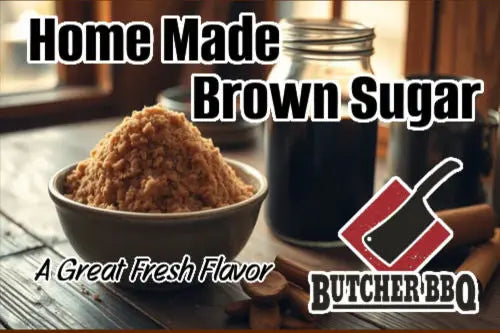
How to Make Your Own Delicious Brown Sugar at Home
In the world of smoking and cooking, brown sugar is a versatile ingredient that adds depth of flavor and a unique texture to a wide range of dishes. From classic chocolate chip cookies to savory marinades, the rich, caramelized notes of brown sugar can elevate any rib recipe. For a substitute for brown sugar that comes from a store, have you ever considered making your own brown sugar at home? It's a simple process that can save you money, allow for customization, and ensure the freshness of this essential pantry staple.
Why Make Your Own Brown Sugar?
There are several compelling reasons to ditch the store-bought brown sugar and take matters into your own hands. Let's explore the benefits of homemade brown sugar:
Cost-Effectiveness
Store-bought brown sugar can be surprisingly expensive, especially if you're an avid baker or cook. By making your own, you can enjoy significant cost savings, as the ingredients required are inexpensive and readily available.
Customization Options
When you make your own brown sugar, you have the freedom to tailor the flavor and texture to your liking. Want a deeper molasses taste? Add a bit more. Prefer a lighter, more subtle sweetness? Adjust the ratio of white sugar to molasses. The possibilities are endless!
Freshness and Flavor
Homemade brown sugar is unbeatable in terms of freshness and flavor. Store-bought varieties can sometimes taste stale or lose their potency over time. By making your own, you'll always have a supply of vibrant, flavorful brown sugar on hand.
Ingredients Needed
To make your own brown sugar, you'll need just two simple ingredients:
- White Sugar: You can use either beet sugar or cane sugar, depending on your preference. Beet sugar tends to have a slightly finer texture, while cane sugar may impart a more robust flavor.
- Molasses: This is the key ingredient that gives brown sugar its distinctive color and taste. You can use light, dark, or blackstrap molasses, depending on the depth of flavor you desire.
Step-by-Step Guide: How to Make Brown Sugar
Making your own brown sugar is a breeze. Follow these simple steps:
- In a mixing bowl, combine the white sugar and molasses. The ratio of sugar to molasses can vary, but a good starting point is 1 cup of white sugar to 1-2 tablespoons of molasses.
- Using a fork or a whisk, mix the ingredients together until the molasses is evenly distributed throughout the sugar. The mixture should have a uniform color and texture.
- If the brown sugar is too dry or crumbly, add a bit more molasses, a teaspoon at a time, until you achieve the desired consistency.
- Conversely, if the mixture is too wet or sticky, add a bit more white sugar to balance it out.
- Once you're satisfied with the texture, transfer the homemade brown sugar to an airtight container for storage.
Best Molasses for Brown Sugar
The type of molasses you choose can have a significant impact on the flavor of your homemade brown sugar. Here's a quick overview of the different molasses options:
- Light Molasses: This has a mild, slightly sweet flavor and is the most versatile choice for baking and cooking.
- Dark Molasses: With a more robust, slightly bitter taste, dark molasses can add depth and complexity to your brown sugar.
- Blackstrap Molasses: The most intense and concentrated in flavor, blackstrap molasses imparts a bold, almost earthy taste to your brown sugar.
Experiment with different molasses varieties to find the one that best suits your taste preferences and the recipes you plan to use your homemade brown sugar in.
Beet Sugar vs. Cane Sugar: Which to Choose?
When it comes to the white sugar base, you have two main options: beet sugar or cane sugar. Both can be used to make delicious brown sugar, but there are some key differences to consider:
Beet Sugar:
- Tends to have a finer, more delicate texture
- Can impart a slightly milder, more subtle flavor
- May be a bit less expensive than cane sugar
Cane Sugar:
- Has a slightly coarser texture
- Offers a more robust, caramelized flavor
- May be a bit more expensive than beet sugar
The choice ultimately comes down to personal preference and the specific flavor profile you're aiming for in your homemade brown sugar. Don't be afraid to try both and see which one you enjoy the most.
Storage Tips for Homemade Brown Sugar
Proper storage is key to keeping your homemade brown sugar fresh and flavorful. Here are some tips:
- Store the brown sugar in an airtight container, such as a mason jar or a resealable plastic bag. This will help prevent the sugar from hardening or absorbing unwanted odors.
- If the brown sugar does start to harden, you can easily soften it by placing a piece of bread or an apple slice in the container. The moisture from these items will help to rehydrate the sugar.
- Homemade brown sugar can typically be stored for up to 6 months, though the flavor and texture may start to degrade after a few months. Be sure to keep an eye on it and use it within a reasonable timeframe.
Conclusion
Making your own brown sugar at home is a simple, cost-effective, and rewarding process. Not only will you save money, but you'll also have the ability to customize the flavor and texture to your liking. With just a few basic ingredients and a bit of mixing, you can enjoy the rich, caramelized goodness of homemade brown sugar in all your baking and cooking endeavors. So why not give it a try and elevate your culinary creations to new heights?




